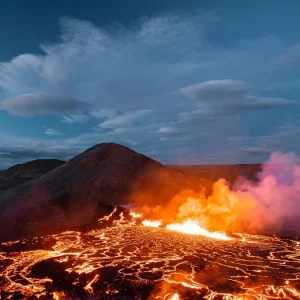Under the influence of climate change, Arctic ice is melting away. This scares climatologists, but also intriguingly creates possible economic benefits. The melted ice has opened trade routes and energy resources, attracting the interest of many of the world’s most powerful nations. However, while the melting ice has created these two potential economic benefits, only the new energy resources will likely have a significant financial impact. Thus, for the foreseeable future, the main economic benefit from Arctic melting lies in resource extraction, not trade.

The Arctic trade route with the most potential to impact global trade is the Northern Sea Route, which runs along Russia’s northern border. This route would potentially shorten the trading distance between East Asia and Northern Europe from 11,200 nautical miles to just 6,500 nautical miles. The shorter distance of the passage potentially allows for quicker shipping turnaround and lower fuel costs. As an added bonus, it also reduces greenhouse gas emissions.
So then why don’t countries flock to the Northern Sea Route? The first problem with the route is it is only open in the summer because of its icy conditions. Consequently, it may attract ships carrying large cargo, like coal or oil, but will be of “limited value for container shipping, which operates on a tight delivery schedule.” In other words, the route will only be of value to specific industries.
Moreover, the Northern Sea Route is only shorter than existing routes for trade between Northern Europe and East Asia. No other region would have cause to use this passage. This further decreases demand for the route; especially because trade between East Asia and Northern Europe is relatively low. In fact, only 2.9% of China’s international trade in 2012 was with Northern Europe. Malte Humpert, the Executive Director of the Arctic Institute, further states that China is looking to increase trade with new markets in Africa and Latin America, rather than European nations, in the coming decades. Therefore, potential demand for this route from Beijing will likely decrease with time.
The costs and availability of ice-breakers present another challenge. Ships traveling through the Northern Sea Route, even in the summer, must pay 400,000 USD for an ice-breaker escort from Russia. This cost is in addition to the higher insurance premiums shippers would have to pay on their cargo because of the hazardous nature of the passage. These extra costs cut into savings from reduced fuel consumption mentioned earlier. The need for ice-breakers also restricts the volume of trade to the amount of ice breakers—of which there is a significant shortage. Russia has the most at thirty seven, and Canada has six while the United States has a paltry two. These shortages will severely limit potential trade volumes.
The aforementioned suggests that the Northern Sea Route will not cause transformative change to global trade anytime soon. In 2013, for example, only seventy one ships traveled through the Northern Sea Route. In comparison, more than 17,000 ships pass through the Suez Canal each year. Ice levels along the Northern Sea Route simply make the route too dangerous, not cost-effective, and limited in scope. However, some argue that with each passing year, the Northern Sea Route becomes more attractive and will eventually become a major passage for trade. Though this may be true, it will take a long time for this to even be possible. One estimate states ships will not be able to travel the route without ice-breakers until 2050. Even then, trade would mostly be limited to summer months and only be useful for commerce between Northern Europe and East Asia.
Nevertheless, melting ice in the Arctic still holds significant economic potential in the energy resources it has made accessible. The U.S. Geological Survey estimates thirteen percent of global oil, thirty percent of global natural gas, and twenty percent of global liquefied natural gas is in the Arctic. However, extracting these resources is not easy. The largest limiting factor to resource extraction in the Arctic is a lack of infrastructure. Developing this needed infrastructure increases start-up costs, making these resources attractive only if demand for energy is high enough. As it happens, according to the International Energy Agency, global demand for oil and gas will increase by more than 35% by 2035. This surge in energy demand will likely outweigh the initial investment costs and propel the extraction of Arctic energy resources.

However, demand for new energy is not equal everywhere. Canada and the United States, for instance, have access to extensive oil sands, shale oil, and gas. Therefore, the Wilson Center concludes these nations will not seriously invest in Arctic energy for another decade or so. In contrast, Russia and Norway are experiencing declining production at their older, existing oil fields. Hence, they will look to take advantage of these resources in the near-term. Russia, in particular, aggressively encourages investment in Arctic energy extraction through tax incentives.
China and Japan also look poised to profit from these resources. Both countries will have increasing demand for energy in the coming decades—Japan because it lacks natural energy resources and China because it will need more energy to fuel its expanding economy. Both countries could thus benefit from Russia’s energy production to their north. China, specifically, has been extremely proactive in their Arctic investments, mainly through Russia nchannels. For instance, China recently loaned over eighty five billion dollars to Russia to build an oil pipeline from Siberia to China and to develop Russia’s Arctic oil fields. These steps have positioned China as one of the main beneficiaries of Arctic melting.
In this Arctic resource drive there are also two surmountable obstacles: territorial disputes and environmental concerns. Some fear disputes over energy resources in the Arctic may escalate because the Arctic is not controlled by a single country. However, most of the energy resources in the Arctic are within 200 nautical miles of Arctic countries, which means they lay within countries’ exclusive economic zones as defined by the UN Convention on the Law of the Sea (UNCLOS). UNCLOS gives countries special rights over resources within 200 nautical miles of their coast and is largely followed by the major Arctic nations, the U.S. excepted. Thus, the prospects of any serious conflict arising over resources in the Arctic are slim.
In terms of the Environment, drilling in the Arctic does have the possibility of causing oil spills and fracturing the Arctic’s already tenuous ecosystems. Moreover, oil companies currently lack comprehensive response plans to deal with an oil spill in the Arctic because ice levels, especially in the winter, may prevent the deployment of emergency response ships. However, taking precautionary steps can mitigate these potential harms if concerns are taken seriously and investments in extra safety measures and emergency response infrastructure are made.
The melting ice in the Arctic opens up needed energy resources, but in the end offers few prospects for new trade routes. As Malte Humpert puts it, trade routes in the Arctic will do little more than create “niche opportunities.” Nevertheless, the Arctic does hold prospects for Arctic countries, and countries like China and Japan, who are in need of energy resources. These countries should invest in the Arctic because while it may not host major trade routes, it does hold benefits for countries that are proactive and willing to make smart long-term investments.





Be First to Comment